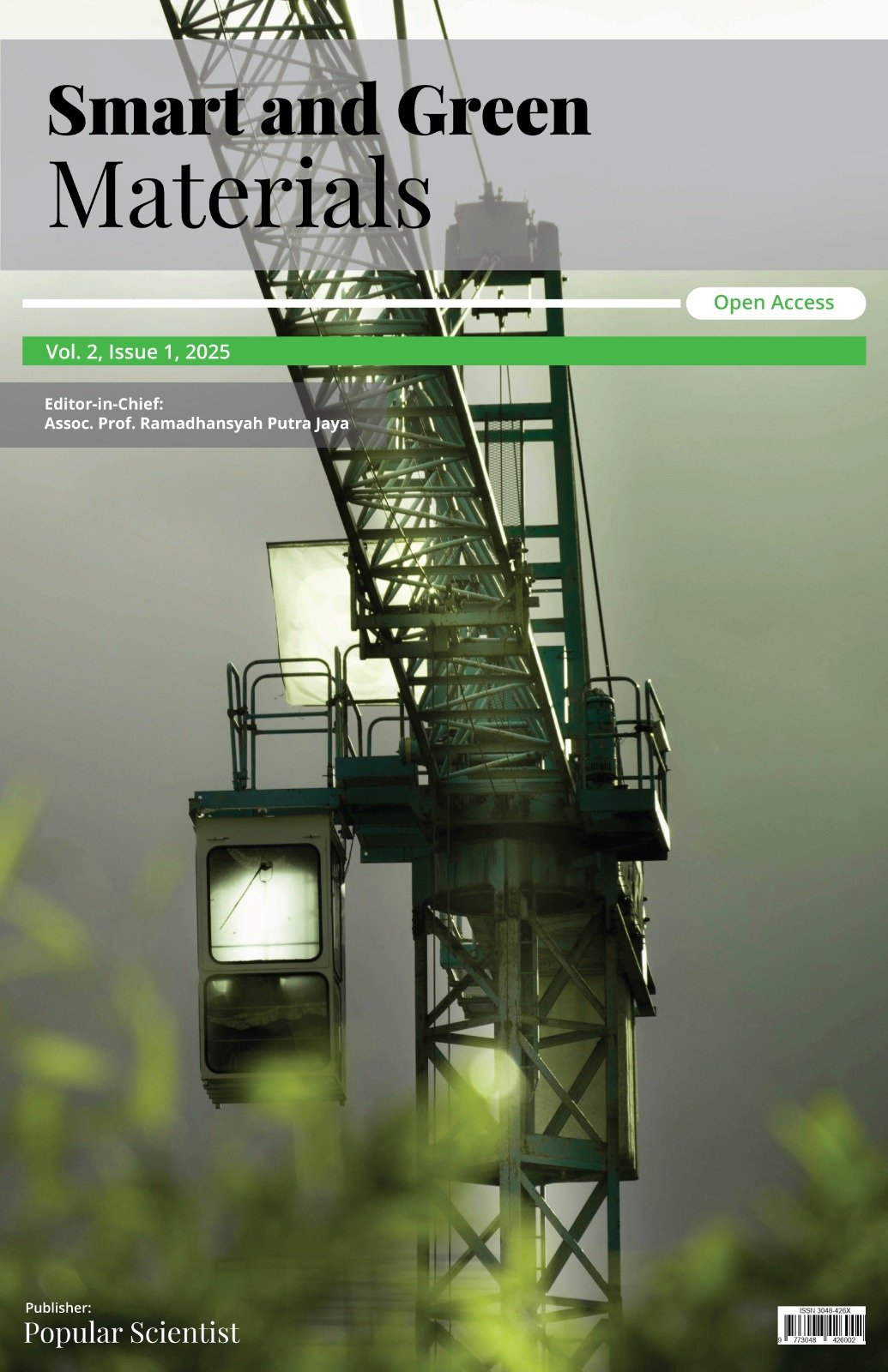Biochar as a Sustainable Cement Replacement for Enhancing Concrete Composite Properties: A Review
DOI:
https://doi.org/10.70028/sgm.v2i1.24Keywords:
Biochar-concrete, Compressive Strength, Sustainable Materials, Carbon Sequestration, Flexural StrengthAbstract
Concrete, a highly adaptable and extensively utilized material, encounters difficulties stemming from the environmental repercussions of cement manufacturing and the exhaustion of natural resources such as river sand and gravel. These concerns have stimulated investigation into sustainable alternatives like biochar, a carbon-dense substance generated by the thermochemical conversion of biomass. Biochar’s distinctive characteristics, such as elevated surface area, porosity, and cation exchange capacity, render it a viable supplemental cementitious material (SCM). This study evaluates the impact of biochar inclusion on concrete’s mechanical characteristics, concentrating on compressive, tensile, and flexural strengths. Research indicates that biochar enhances early-age compressive strength, with findings documenting an increase of up to 40% at a 2% replacement rate. Nonetheless, elevated doses (>5%) diminish strength owing to heightened porosity and water requirements. Flexural strength exhibited considerable enhancements, especially with presoaked biochar and certain feedstocks, but tensile strength advantages were noted at less replacement levels (e.g., 5%). The results underscore biochar’s potential as a supplementary cementitious material for sustainable concrete, including enhancements in early-age strength and environmental advantages such as carbon sequestration. Future research should concentrate on improving biochar dose and assessing long-term performance to improve its applicability in extensive building uses.
Downloads
References
N. Mohamad, K. Muthusamy, R. Embong, A. Kusbiantoro, and M. H. Hashim, “Environmental Impact of Cement Production and Solutions: A Review,” Mater. Today Proc, vol. 48, pp. 741–746, 2021.
C. M. Mah, T. Fujiwara, and C. S. Ho, “Life Cycle Assessment and Life Cycle Costing toward Eco-Efficiency Concrete Waste Management in Malaysia,” J. Clean. Prod, vol. 172, pp. 3415–3427, 2018.
S. H. Mahi, M. F. Sheik, T. A. Ridoy, N. Ahamed, and N. Zaman, “Advances and innovations in utilizing steel slag aggregate for sustainable concrete construction: a comprehensive review,” in 7th International Conference on Civil Engineering for Sustainable Development (ICCESD 2024), Bangladesh, 2024. [Online]. Available: http://www.iccesd.com/proc_2024/Papers/684.pdf
K. L. Scrivener, V. M. John, and E. M. Gartner, “Eco-Efficient Cements: Potential Economically Viable Solutions for a Low-CO2 Cement-Based Materials Industry,” Cem. Concr. Res, vol. 114, pp. 2–26, 2018.
Z. Syahida Adnan, N. F. Ariffin, S. M. Syed Mohsin, and N. H. Abdul Shukor Lim, “Review Paper: Performance of Rice Husk Ash as a Material for Partial Cement Replacement in Concrete,” Mater. Today Proc, vol. 48, pp. 842–848, 2022.
M. Ahmed et al., “An Overview of Asian Cement Industry: Environmental Impacts,” Res. Methodol. Mitig. Meas. Sustain. Prod. Consum, vol. 28, pp. 1018–1039, 2021.
D. Suarez-Riera, L. Restuccia, and G. A. Ferro, “The Use of Biochar to Reduce the Carbon Footprint of Cement-Based Materials,” Procedia Struct. Integr., vol. 26, pp. 199–210, 2020.
S. Kant Bhatia et al., “Trends in Renewable Energy Production Employing Biomass-Based Biochar,” Bioresour. Technol., vol. 340, p. 125644, 2021.
P. R. Yaashikaa, P. S. Kumar, S. Varjani, and A. Saravanan, “A Critical Review on the Biochar Production Techniques, Characterization, Stability and Applications for Circular Bioeconomy,” Biotechnol. Reports, vol. 28, p. 570, 2020.
W. Zhao, H. Yang, S. He, Q. Zhao, and L. Wei, “A review of biochar in anaerobic digestion to improve biogas production: performances, mechanisms and economic assessments,” Bioresour. Technol., vol. 341, p. 125797, 2021.
Z. Fang et al., “Conversion of biological solid waste to graphene-containing biochar for water remediation: A critical review,” Chem. Eng. J., vol. 390, p. 124611, 2020.
F. Yang, S. Zhang, Y. Sun, D. C. W. Tsang, K. Cheng, and Y. S. Ok, “Assembling Biochar with Various Layered Double Hydroxides for Enhancement of Phosphorus Recovery,” J. Hazard. Mater., vol. 365, pp. 665–673, 2019.
S. S. Sahoo, V. K. Vijay, R. Chandra, and H. Kumar, “Production and Characterization of Biochar Produced from Slow Pyrolysis of Pigeon Pea Stalk and Bamboo,” Clean. Eng. Technol., vol. 3, p. 100101, 2021.
P. D. Dissanayake et al., “Biochar-based adsorbents for carbon dioxide capture: A critical review,” Renew. Sustain. Energy Rev., vol. 119, p. 109582, 2020.
L. Wang et al., “Biochar as green additives in cement-based composites with carbon dioxide curing,” J. Clean. Prod., vol. 258, p. 120678, 2020.
S. Gupta and H. Kua, “Effect of water entrainment by pre-soaked biochar particles on strength and permeability of cement mortar,” Constr. Build. Mater., vol. 159, pp. 107–125, 2018.
A. R. Asadi Zeidabadi, Z. Bakhtiari, S. Abbaslou, H. Ghanizadeh, “Synthesis, characterization and evaluation of biochar from agricultural waste biomass for use in building materials,” Constr. Build. Mater., vol. 181, pp. 301–308, 2018.
A. Danish, M. Ali Mosaberpanah, M. Usama Salim, N. Ahmad, F. Ahmad, and A. Ahmad, “Reusinsg Biochar as a Filler or Cement Replacement Material in Cementitious Composites: A Review,” Constr. Build. Mater., vol. 300, p. 124295, 2021.
R. A. Mensah et al., “Biochar-Added Cementitious Materials—A Review on Mechanical, Thermal, and Environmental Properties,” Sustainability, vol. 13, p. 9336, 2021.
H. Maljaee, R. Madadi, H. Paiva, L. Tarelho, and V. M. Ferreira, “Incorporation of Biochar in Cementitious Materials: A Roadmap of Biochar Selection,” Constr. Build. Mater., vol. 283, p. 122757, 2021.
K.-H. Tan, T.-Y. Wang, Z.-H. Zhou, and Y.-H. Qin, “Biochar as a Partial Cement Replacement Material for Developing Sustainable Concrete: An Overview,” J. Mater. Civ. Eng., vol. 33, p. 3121001, 2021.
B. A. Akinyemi and A. Adesina, “Recent Advancements in the Use of Biochar for Cementitious Applications: A Review,” J. Build. Eng., vol. 32, p. 101705, 2020.
W. C. Choi, H. D. Yun, and J. Y. Lee, “Mechanical Properties of Mortar Containing Bio-Char From Pyrolysis,” J. Korea Inst. Struct. Maint. Insp., vol. 16, pp. 67–74, 2012.
S. Gupta, H. Kua, and S. Cynthia, “Use of biochar-coated polypropylene fibers for carbon sequestration and physical improvement of mortar,” Cem. Concr. Compos., vol. 83, pp. 171–187, 2018.
S. Gupta, H. Kua, and S. D. Pang, “Biochar-mortar composite: Manufacturing, evaluation of physical properties and economic viability,” Constr. Build. Mater., vol. 167, pp. 874–889, 2018.
A. Sirico et al., “Biochar from wood waste as additive for structural concrete,” Constr. Build. Mater., vol. 303, p. 124500, 2021.
J. H. Park, Y. U. Kim, J. Jeon, B. Y. Yun, Y. Kang, and S. Kim, “Analysis of biochar-mortar composite as a humidity control material to improve the building energy and hygrothermal performance,” Sci. Total Environ., vol. 775, p. 145552, 2021.
Y. U. Kim, B. Y. Yun, J. Nam, J. Y. Choi, S. Wi, and S. Kim, “Evaluation of thermal properties of phase change material-integrated artificial stone according to biochar loading content,” Constr. Build. Mater., vol. 305, 2021.
X. Yang and X. Y. Wang, “Hydration-Strength-Durabilitys-Workability of Biochar-Cement Binary Blends,” J. Build. Eng., vol. 42, p. 103064, 2021.
P. Chindaprasirt and S. Rukzon, “Strength, porosity and corrosion resistance of ternary blend Portland cement, rice husk ash and fly ash mortar,” Constr. Build. Mater., vol. 22, pp. 1601–1606, 2008.
S. K. Gupta Harn Wei, “Effect of water entrainment by pre-soaked biochar particles on strength and permeability of cement mortar,” Constr. Build. Mater., vol. 159, no. NA, pp. 107–125, 2018, doi: http://dx.doi.org/j.conbuildmat.2017.10.095
A. S. Akhtar Ajit K., “Novel biochar-concrete composites: Manufacturing, characterization and evaluation of the mechanical properties.,” Sci. Total Environ., vol. 616–617, no. NA, pp. 408–416, 2017, doi: http://dx.doi.org/j.scitotenv.2017.10.319
H. P. Maljaee H.; Madadi, Rozita; Tarelho, Luís A.C.; Morais, Miguel M.; Ferreira, Victor M., “Effect of cement partial substitution by waste-based biochar in mortars properties,” Constr. Build. Mater., vol. 301, no. NA, pp. 124074-NA, 2021, doi: http://dx.doi.org/10.1016/j.conbuildmat.2021.124074
D. R. Suarez-Riera Luciana; Ferro, Giuseppe Andrea, “The use of Biochar to reduce the carbon footprint of cement-based materials,” Procedia Struct. Integr., vol. 26, no. NA, pp. 199–210, 2020, doi: http://dx.doi.org/10.1016/j.prostr.2020.06.023
R. A. A. Khushnood Sajjad; Restuccia, Luciana; Spoto, Consuelo; Jagdale, Pravin Vitthal; Tulliani, Jean Marc Christian; Ferro, Giuseppe Andrea, “Carbonized nano/microparticles for enhanced mechanical properties and electromagnetic interference shielding of cementitious materials,” Front. Struct. Civ. Eng., vol. 10, no. 2, pp. 209–213, 2016, doi: http://dx.doi.org/10.1007/s11709-016-0330-5
S. K. Ahmad Rao Arsalan; Jagdale, Pravin Vitthal; Tulliani, Jean Marc Christian; Ferro, Giuseppe Andrea, “High performance self-consolidating cementitious composites by using micro carbonized bamboo particles,” Mater. Des., vol. 76, no. NA, pp. 223–229, 2015, doi: http://dx.doi.org/j.matdes.2015.03.048
S. S. Praneeth Laureen; Zeng, Maria; Dubey, Brajesh; Sarmah, Ajit K., “Biochar admixtured lightweight, porous and tougher cement mortars: Mechanical, durability and micro computed tomography analysis,” Sci. Total Environ., vol. 750, no. NA, pp. 142327-NA, 2020, doi: http://dx.doi.org/j.scitotenv.2020.142327
S. K. Gupta Harn Wei; Koh, Hui Jun, “Application of biochar from food and wood waste as green admixture for cement mortar.,” Sci. Total Environ., vol. 619–620, no. NA, pp. 419–435, 2017, doi: http://dx.doi.org/j.scitotenv.2017.11.044
Z. A. B. Zeidabadi Somayeh; Abbaslou, Hakime; Ghanizadeh, Ali Reza, “Synthesis, characterization and evaluation of biochar from agricultural waste biomass for use in building materials,” Constr. Build. Mater., vol. 181, no. NA, pp. 301–308, 2018, doi: http://dx.doi.org/j.conbuildmat.2018.05.271
Y. Ling, X. Wu, K. Tan, and Z. Zou, “Effect of Biochar Dosage and Fineness on the Mechanical Properties and Durability of Concrete,” Materials (Basel)., vol. 16, no. 7, pp. 1–13, 2023, doi: http://dx.doi.org/10.3390/ma16072809
Downloads
Published
Issue
Section
License
Copyright (c) 2025 Md. Saniul Haque Mahi, Md. Abdul Mun-Im-Dinar, Tanjun Ashravi Ridoy (Author)

This work is licensed under a Creative Commons Attribution-NonCommercial 4.0 International License.













